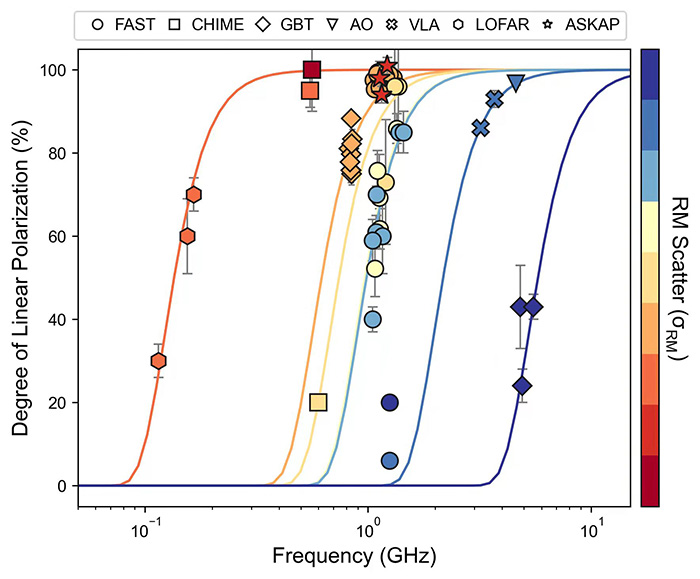
A correlation between the observed frequencies and polarizations of the energetic radio pulses suggests the bursts originate in active regions such as magnetars in binary systems.

The Five-Hundred-Meter Aperture Spherical Radio Telescope in southwestern China is the largest single-dish radio telescope in the world. Credit: Yongkun Zhang
Fast radio bursts, or FRBs, are very short, extremely bright extragalactic radio flashes that light up the sky thousands of times a day. The bursts peak at frequencies between 400 MHz and 8 GHz, and they sometimes but not always repeat.
Since the first FRB signal was unearthed from archived observation data 15 years ago, scientists have tried to determine their origin. Thanks to highly sensitive radio telescopes on Earth, several candidate sources have emerged. For example, astronomers determined in 2017 that the well-studied repeating FRB 121102 dwells in a bright star-forming region inside a dwarf galaxy 3 billion light-years away. And two years ago researchers traced FRB 200428 to a distant magnetar, a neutron star with an ultrastrong magnetic field (see Physics Today, January 2021, page 15).
In a paper published in the 18 March Science, researchers analyzed the polarization of active FRBs and offered the first systematic description of the environments in which they reside. The results indicate that the bursts likely originate in young or complex environments such as supernova remnants.
"This paper confirms that FRBs only occur in special places in the universe,” says Ue-Li Pen of the Academia Sinica Institute of Astronomy and Astrophysics in Taiwan, who was not involved with the research. “It’s an important step toward better understanding the immediate environments of those mysterious bursts.”
An FRB typically lasts for a few milliseconds but releases about as much energy as the Sun does in a year. The raw energy of the outbursts has led astronomers to suspect that extremely powerful magnetic fields, like those of a neutron star, are required to produce them. If that is the case, then the magnetic fields should also strongly polarize the outgoing burst of radio waves. Indeed, in 2018 the Green Bank Telescope in West Virginia detected nearly 100% polarization from FRB 121102.
But in 2019, when the Five-Hundred-Meter Aperture Spherical Radio Telescope (FAST) detected 1652 eruptions from FRB 121102, no polarization was observed. “It struck us as a big surprise, since other telescopes had seen high polarization from the same source, and FAST has unparalleled sensitivity,” says paper coauthor Di Li of the National Astronomical Observatories of China in Beijing. He is the chief scientist of FAST, the world’s largest single-dish radio telescope, which sits in a natural depression in southwestern China.
Li and colleagues wondered whether their surprising finding would apply to other bursts. So they compiled the polarization measurements of 21 repeating FRBs, which account for about 90% of all the known repeating bursts, for a systematic examination. They discovered that polarization increases and decreases with the observed frequency of the bursts. At low frequencies, the bursts can be completely unpolarized. “We found 2 GHz to be the threshold,” Li says. That would explain why FAST failed to detect polarization: It probed FRB 121102 at 1–1.5 GHz, whereas the Green Bank Telescope’s polarization finding came at frequencies of 3 GHz and above.
To explain why the polarization of FRBs drops quickly at lower frequencies, the team proposed a picture in which the immediate environment—rather than the source itself—plays a central role. Although the bursts are likely produced at their source fully polarized, they travel through the nearby gas or plasma on slightly different paths on the way to telescopes on Earth. In the process, the waves encounter different electron densities and magnetic field strengths in front of or around them, which leads to slightly different Faraday rotations of their polarization angles. The magnitude of the rotation is greater at lower frequencies than at higher ones. By the time the lower-frequency waves are picked up by a telescope’s receiver, they no longer show the initial polarization and appear depolarized. “Averaging over multiple paths, the polarization in lower frequencies is more smeared than in higher frequencies,” says paper coauthor Bing Zhang of the University of Nevada, Las Vegas.
The findings in the Science paper fit into our current understanding of repeating FRB sources as relatively young, energetic objects, and they are consistent with studies that located some of the sources in star-forming regions within galaxies, says Jason Hessels of the University of Amsterdam in the Netherlands.

The degree of linear polarization for multiple fast radio bursts (nine shown here, designated by color) increases with the burst frequency. The shapes represent the radio telescopes that made the observations. Each burst has a different rotation measure (RM), which quantifies the Faraday rotation of polarization. Credit: Y. Feng et al., Science 375, 1266 (2022)
If an FRB source has ionized gas or plasma around it with magnetic fields capable of depolarizing radio waves, it means the environment is relatively young, explains Pawan Kumar of the University of Texas at Austin. A common scenario is a supernova remnant, where a newborn neutron star lives at the heart of a cloud made of leftover material from the explosion of the precursor star. It takes tens of thousands of years for the cloud to disperse, but the neutron star will remain active much longer after that, says Kumar.
Loss of polarization can also indicate a not-so-young but relatively complex environment. For instance, some neutron stars live close to the supermassive black hole at the center of a galaxy. Radio bursts from such neutron stars would need to go through the gas or plasma that surrounds the black hole.
Another example of a complex environment is a magnetar that orbits another star. The pair may interact and create a turbulent environment within which the magnetar’s bursts would scatter and depolarize. “The magnetar in this scenario doesn’t have to be very young,” Zhang says.
All those scenarios may turn out to be valid. There used to be more than 50 theoretical models about the physical origin of FRBs. All but a few have been ruled out, but that doesn’t mean that only one offers a correct description. “To think that there’s only one origin would be underestimating nature’s creativity,” Zhang says.
If the paper’s conclusions are confirmed by future detections, it could be a major step toward completing the cosmic puzzle of FRBs. “I’m glad the team was able to model the data relatively early,” Pen says. “This is one of those papers that I look at and I’m thinking, ‘It’s a very good result, and we should’ve done it first.’”
Pen believes the field will see major discoveries within the next five years. He is leading the development of a telescope called the Bustling Universe Radio Survey Telescope in Taiwan, which has a large field of view and long baseline tailored for observing FRBs relatively close to Earth. Once complete, the telescope will join the Canadian Hydrogen Intensity Mapping Experiment and other radio telescopes to accurately locate the host galaxies of FRBs, including one-off bursts. Researchers want to answer the question of how many types of FRBs exist: Are they mostly single events, or do they all repeat at some cadence, whether separated by only the blink of an eye or spaced out over hundreds or thousands of years?
The FRB community also hopes to use the frequent bursts to understand the evolution of the universe. Since FRBs are the only coherent radiation sources from the deep universe, researchers have proposed using bursts that are gravitationally lensed by nearer galaxies to make measurements of features including dark matter, baryonic matter, and the expansion rate of the universe. And by detecting and pinpointing the origin of enough extremely distant bursts, astronomers may be able to use FRBs to study reionization, a period in the history of the universe after the first stars and galaxies appeared. “It’s all very challenging yet very attractive work,” Zhang says. (Physics Today)

86-10-68597521 (day)
86-10-68597289 (night)

86-10-68511095 (day)
86-10-68512458 (night)

cas_en@cas.cn

52 Sanlihe Rd., Xicheng District,
Beijing, China (100864)

